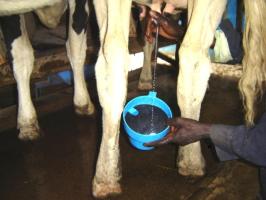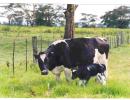
|
Cattle
|
| Introduction | Milking | |||
| Cattle Health and Welfare | Beef Management Systems | |||
| Economics of Dairy production | Products | |||
| Diseases | Information Source Links | |||
| Calving and calf rearing |
Introduction
In mixed farming systems, cattle play a major role in household food security. In some of these systems manure is more important than milk or meat, as it helps to improve or maintain soil fertility and hence food production. As resource-poor households in most of the developing world cannot afford chemical fertilisers, manure is generally the only source of nutrients applied to the crop fields. As draught animals, cattle also allow households to plough and cultivate more land and remove labour bottlenecks during weeding. Cattle have been used traditionally as draught animals in many parts of the developing world, especially in Ethiopia, parts of East and Southern Africa, and Asia.
In Kenya, the Arid and Semi Arid Lands (ASAL) make up 84% of Kenya's total land surface; supports about 8 million Kenyans, as well as 50% of the livestock and 65% of the wildlife population. Kenya ASALs produce the bulk of the red meat consumed in Kenya under nomadic pastoralism and ranching production systems supporting about 6 million beef cattle. The beef industry represents an important proportion of the economy accounting for about 70% of total beef meat consumed in the country. Apart from meat beef cattle have several benefits, which include; milk, hides and skins, draught power for land preparation and transport and manure too.
Smallholder dairy farmers in East and Southern Africa produce over 80% of the milk consumed in this region. Estimates from 2005 rate annual milk production in Kenya at 3.2 billion litres, worth over 50 billion Ksh annually. This sector of agriculture, forming an economical basis of millions of livelihoods, has huge potential for improvement through management practices, better feeding and breeding practices, disease management and improved care of the young.
Well worked out economics of dairy production is essential for making profits from dairy production. The economics of animal keeping is very dependant on the basic corner stones: Health, welfare and basic good nutrition (For more information on Nutrition in Dairy animals see here)
Cattle Health and Welfare
Cattle health and welfare are two very important aspects of dairy production. Most dairy farmers have felt the painful loss of a good cow but may not always be aware why the loss occurred. Many losses can be avoided by paying careful attention to preventive health care and seeing that the animals are comfortable and able to function the way nature intended. The following are the main preventive measures every serious dairy farmer should consider:
- Proper feeding and prevention of starvation is the first aspect to be addressed
- Preventive health care such as regular tick control
- Prevention of management diseases
- Vaccination of animals according to veterinary recommendations for the area
- Good housing/ milking facilities, where proper hygiene can be managed
- Good supervision to ensure incidental diseases are dealt with in a timely and appropriate manner
1. Hunger and thirst
Cows spend 7-9 hours a day grazing and nearly the same amount of time ruminating the ingested feed. Adequate provision of fibre is an essential requirement for a healthy rumen environment. Fibre ranging from 7-10 cm in length (approximately the width of the muzzle) is optimum and prevents cattle selecting through the ration and discarding longer fibre. Long fibre stimulates cudding, which in turn stimulates saliva production, and saliva is the primary rumen buffer, preventing acidosis. The optimum forage to concentrate ratio to maintain rumen health and pH at 6 - 6.8 is 60:40 on a dry matter basis (roughage: concentrate). Rumen acidosis is the most common forage related stress that we see in dairy cattle. Rumen acidosis is primarily due to inadequate levels of effective fibre in the rations of those cows. High yielding cows are commonly fed diets containing 45 - 55 % forage on a DM basis. Finishing beef cattle are often fed a diet consisting of 25 - 40% forage on a DM basis.
2. Freedom from discomfort
A long lying period is important in the prevention of lameness in dairy cows, and it has also been noted that cows spend significantly more time lying down ruminating, as opposed to standing ruminating. Because a large percentage of cattle time is spent ruminating whilst loafing, dry comfortable hygienic bedding that encourages cows to lie down is highly important.
3. Freedom from pain, injury or disease
Hygienic bedding material in order to minimize the risk of mastitis is a priority. Being able to lie down is very important to cattle. When given choice and optimum conditions, cows are known to spend 50% or more of their time lying down. A comfortable resting surface is an important aspect in encouraging cows to lie down. Cattle prefer dry, soft, insulating bedding, and subsequently show reduced incidence and severity of leg injuries.
In addition, the following need to be adhered to:
In addition, the following need to be adhered to:
- Stocking Rate: A stocking rate of 1 to 1.4 Lu's/ha is suitable for organic farming.
- Soil Fertility: It is easier to farm organically where soil fertility is medium to high. Rock phosphate has been used successfully on organic farms.
- Livestock System: Suckler cows and sheep are suited to organic farming. Under good husbandry natural immunity to parasites and diseases can develop. A grazing system which reduces the worm burden should be established.
- Clover: Clover is essential at higher stocking rates. Good clover stands can double pasture production, grass quality and animal performance is improved.
- Tillage: Some tillage is a major bonus. It provides cheaper grain and straw and allows the renewal of grassland. From 2008 only organic cereals can be fed to ruminants.
- Housing: The conventional straw bedded sheep house conforms to organic standards. In cattle housing a straw bedded lying area is essential (the feeding area may be slatted).
For information on Animal Welfare and Organic Certification Norms in Cattle see under following link click here
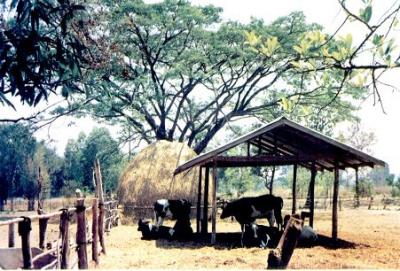 |
| Housing |
| © Falvey |
Tick control through Acaricides:
 |
| A cow walking out of a plunge dip |
| © W. Ayako, KARI Naivasha |
In East Africa many serious diseases are transferred by ticks. This is less severe in 0-grazing units than in animals grazing pastures and interacting with a certain amount of wildlife. The picture shows a typical cattle dip, preventing insect and particularly tick borne diseases, by letting the animals jump into a dip filled water with added acaricide (tick poison). Prevention of tick borne diseases is by spraying, dipping or using Pour-on chemicals to get rid of the ticks.
There are several different types of acaricides available on the market and it is advisable to keep interchanging them to avoid ticks becoming resistant. Several botanicals have also been found to be effective in place of acaricides. See an TOF article on alternative methods of tick control and botanicals here
For organic farmers it always important to have as little poison on the farm as possible, and to choose the least harmful types of acaricides. However even organic farmers have to spray their animals, as regulations demand that the animals are kept healthy and comfortable.
For organic farmers it always important to have as little poison on the farm as possible, and to choose the least harmful types of acaricides. However even organic farmers have to spray their animals, as regulations demand that the animals are kept healthy and comfortable.
Dips
These are structures built on ranches or communally where animals are driven through a bath of acaricides. It is an easy procedure but quite costly, and there can often be cases of animals that swallow some amount of dip solution with varying results from death of the animal to some degree of poisoning.
Dips must be carefully maintained to ensure the concentration of acaricides is appropriate at all times. Too low concentration can lead to ineffective tick control and tick resistance to the acaricide used. There is also the problem of environmental pollution when dips need to be cleaned out. Where to throw all the old toxic waste?
Spray-races
Spray races are modernized dips, where cattle walk through a set of nozzles spraying acaricides to cover the whole animal. The spraying is done mechanically by pumps, with very little need for human labour. It is less hazardous than dips, and as the left over spray is recollected, strained and reused there is less waste of acaricides. The concentration of acaricides is also much easier to regulate than for dips. As animals walk into the spray race preparing to meet the spray and closing their mouths and too much inbreathing, the spray races have less problems of poisoning of animals than dips.
Back pack sprayer
As most small scale farmers do not have access to dips or spray races, the best option becomes spraying by back pack sprayer. This is labour consuming and it is easy to miss areas on the animals (often under the tail or behind leg joints), where ticks can then hide and multiply. It is also important to avoid spraying directly into the animal's noses and open eyes. Animals can go blind from getting acaricides into their eyes, and can get poisoned by too much acaricide sprayed on their noses.
Pour-on
Pour-on acaricides are slowly becoming more popular. These are formulated in a way that a certain amount is simply poured along the back of the animal, from where it distributes itself evenly over the hide of the animal. Pour-on's are very effective but also quite expensive.
Economics of Dairy production
Economics of Dairy production: Estimation of returns from different scenarios of smallholder systems
Dairy farming is an important source of income and employment in Kenya. The population of dairy cattle is estimated to be about 3 million in the country. The cattle are kept under extensive and intensive management systems. Extensive systems are confined to a few ranches and large scale farms. The intensive systems are the most predominant and comprise zero-grazing and semi-zero grazing systems. Arising from reports and data collected by different institutions, a rough estimate of returns obtainable from dairy enterprise can be calculated. The important inputs for dairy production include land, labour and capital. Land
Land is the most important resource for feed production besides being used for infrastructure development. Estimates of land required to raise a livestock unit (cow and calf) under different scenarios vary with ecological zone, forage management practices, and feeding strategies. For instance, under intensive forage production in high rainfall (e.g. UH 2- 4; LH 2-4; UM 1-4, LM1-3 link to agro-ecological zones) areas, one acre can sustain a livestock unit. In areas with low rainfall, the acreage required to sustain a livestock unit increase drastically and may reach 10 acres under moderate management. Labour
Dairy production is generally labour intensive regardless inclining towards machinery or human to perform tasks. Labour is generally estimated to take about 40-50% of the total cost. Capital
The most important capital in dairy industry are the cows and construction of management infrastructure (shed, milking crushes, fencing, and husbandry apparatus/equipment). The cost of an in-calf heifer vary from Ksh 40, 000-120,000/- (USD 540- 1600) depending on genetic potential. Simple cow sheds for holding upto 4 cows are estimated to cost (50,000-100,000/- ) depending on source of materials and labour. The cost can be substantially reduced by using own timber, building stones, rainwater and home labour during construction. Important recurrent costs include purchase of feeds, artificial insemination, health care and milk marketing (transport, preservation and value addition).Estimated returns from dairy systems based cows with varied production potential under different managements (production inputs)
The following 5 examples of how to calculate economic returns from dairy cattle should only be taken as guidelines. It is very important that each dairy farmer calculates production figures based on available feedstuffs in the area, what can be grown on the farm and the cost of growing it, as well as the price of milk that can be obtained from the market. Under Animal Nutrition and feed rations (link please) it is described what dairy cown need in terms of nutrition. Each dairy farmer must decide the best possible production system at the most economical costs in order to get a decent income from dairy production. Also health and welfare of the animals (see under Animal welfare and organic norms for further information) are very important aspects, as too many veterinary bills or loss of productive animals are very costly affairs.
It is always prudent to reduce costs as much as possible bearing in mind that some costs like basic nutrition, health and animal welfare are the cornerstones of a profitable dairy production.
General assumptions:
- A dairy cow consumes feed dry matter (DM) amounting to 3% of its body weight daily
- No mortality occurs
- The calf is raised successfully as replacement stock or sold after attainment of physiological maturity
- Artificial insemination (AI) is practiced under intensive and semi-intensive systems. Natural mating is practiced under extensive/pastoral systems
- There is unlimited milk market
- Milk is sold at farm gate without value addition or any form of processing
- A bale of hay weighs 14.4 kg (DM basis)
- Labour costs vary with systems and locality
- Labour is not hired under pastoral system
Example 1: Dairy cow (Friesian or Ayrshire) weighing 400 kg kept in high potential highlands of Kenya (UH, LH, UM or LM climate) under intensive or zero grazing management based on outsourced (bought) feeds.
Daily diet example
| Feedstuff | Amount dry matter (DM) basis (kg) |
Amount Fresh (kg) |
| *Napier grass (kg) |
5 | 25 |
| **Lucerne hay (kg) |
3 | 3.5 |
| **Dairy meal (kg) |
4 | 4.5 |
| Maclick super |
0.12 ( 120 g) | 0.12 ( 120 g) |
| Total | 12.12 | 33.12 |
Assumptions: * DM content = 20%, * *DM content = 90%
- Note:
- 1. Forages with low DM content to be weighed fresh and wilted before feeding.
- 2. Fresh water to be available free choice
- 3. Wastages to be compensated for during feeding
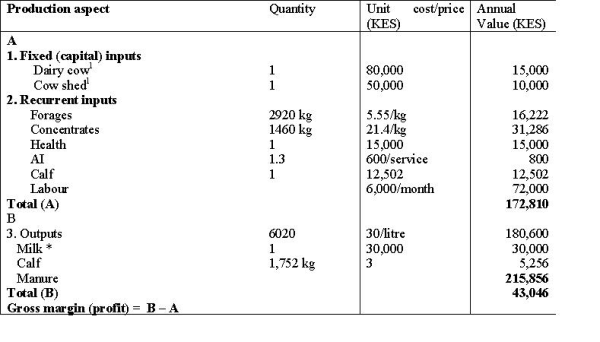 |
1 Cow and cowshed are considered as having long-term value; annual costs are estimated to cater for risks of unavoidable losses and depreciation
*Calculations based on average daily milk = 20 litres in 301 days lactation
*Calculations based on average daily milk = 20 litres in 301 days lactation
Example 2: Dairy cow (Friesian or Ayrshire) weighing 400 kg kept in high potential highlands of Kenya (UH, LH, UM or LM climate) under intensive or zero grazing management based on home grown forages.
Daily diet example
| Feedstuff | Amount dry matter (DM) basis (kg) |
Amount Fresh (kg) |
| **Napier or Columbus or Guinea grass or combination |
3 | 15 |
| **Kikuyu or Rhodes or Star grass or combination |
2 | 8 |
| *Sweet potato vines or Lucerne or desmodium |
2 | 13.5 |
| **Calliandra or Sesbania or Leucaena |
1 | 5 |
| ***Dairy meal | 4 | 4.5 |
| Maclick super | 0.12 ( 120 g) | 0.12 ( 120 g) |
| Total | 12.12 | 46 |
 |
1 Cow and cowshed are considered as having long-term value; annual costs are estimated to cater for risks of unavoidable losses and depreciation
*Calculations based on average daily milk = 20 litres in 301 days lactation
From the above comparison it can be seen that home production of forages gives a higher return from similar systems, but that dairy production can still be profitable when fodders are bought in (depending on price).
Example 3: Dairy cow (Friesian or Ayrshire) weighing 400 kg under intensive management in a peri-urban area fed on purchased forages, agro-industrial by products and concentrates based diets.
Daily diet example
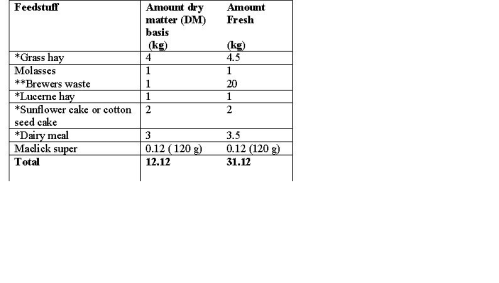 |
Assumptions:
- * DM content = 90%;
- * *DM content = 5%
- Note:
- 1. Forages with low DM content to be weighed fresh and wilted before feeding.
- 2. Fresh water to be available free choice
- 3. Wastages to be compensated for during feeding
 |
1 Cow and cowshed are considered as having long-term value; annual costs are estimated to cater for risks of unavoidable losses and depreciation
*Calculations based on average daily milk = 20 litres in 301 days lactation
From example 3 we can learn that one must be very careful about feeding expenses. Buying in too much feed at too high prices will cancel out any profit and even make a loss. It is very important to always list all expenses and evaluate whether they are justified.
Example 4: Jersey cow weighing 300 kg under intensive system (zero grazing) in Western or Eastern Kenya (UM or LM climate) receiving at least 800 mm rainfall fed on home grown forages.
Daily diet example
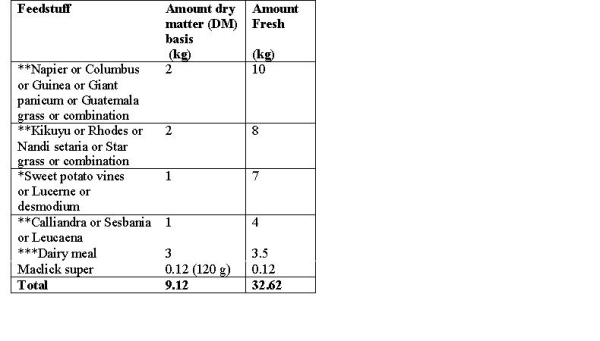 |
Assumptions:
- * DM content = 15%;
- * *DM content = 20%;
- ***DM content = 90%
- Note:
- 1. Forages with low DM content to be weighed fresh and wilted before feeding.
- 2.Fresh water to be available free choice
- 3. Wastages to be compensated for during feeding
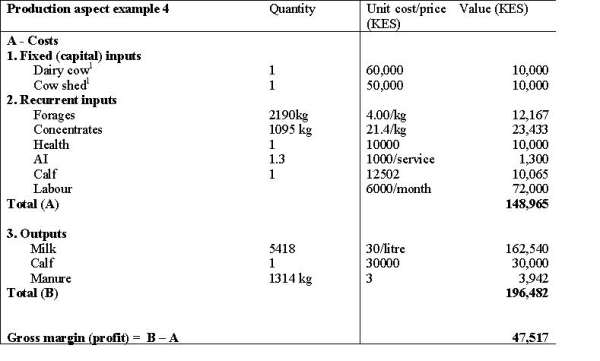 |
1 Cow and cowshed are considered as having long-term value; annual costs are estimated to cater for risks of unavoidable losses and depreciation
*Calculations based on average daily milk = 18 litres in 301 days lactation
Jersey cows, being smaller animals, eat less than Friesian or Ayrshire cows, and has better quality milk. Some dairies will pay extra for the good quality milk (higher cream and protein content) but this is not yet common in Kenya
Example 5. Pastoral system keeping dual-purpose Sahiwal cow under IL conditions grazing good quality pasture (Themeda, Bothriochloa, Cynodon, Cenchrus or a mixture of these)
 |
1 Cow and cowshed are considered as having long-term value; annual costs is estimated to cater for risks of unavoidable losses and depreciation
2 Manyatta Bomas are constructed under the pastoral system; annual cost is estimated
*Calculations based on average daily milk = 4 litres in 260 days lactat
Diseases
Types of Diseases
Diseases in cattle are categorized into two:1. Notifiable diseases
| Name | Type of vaccination | Remarks |
| Lumpy Skin Disease (LSD) | Once a year | - |
| Contagious Bovine Pleuro pneumonia (CBPP) | Once a year | - |
| Rinderpest | Every 6 months | - |
| Foot and Mouth Disease (FMD) | Every 6 months | - |
| Rift Valley Fever | Yearly | Also affects human beings |
| Anthrax and Blackquarter | Every 9 months | Also affects human beings |
| Brucellosis | Once in a lifetime(to calves only) | Also affects human beings |
| Malignant catarrhal fever | No vaccination | Avoid contact with wildebeest |
| East Coast Fever (ECF) | No vaccination | Treatable |
| Trypanasomiasis | No vaccination | Protective medicine available |
Note: All notifiable diseases require imposition of quarantine.
2. Non-notifiable diseases (all the rest of the diseases)
- Management diseases - such as mastitis, milk fever, diarrhea - for further information see here
- Tick and insect borne diseases - such as anaplasmosis, babesiosis, East Coast Fever, Rift Valley Fever etc - for further information see here and here
- Eye problems - for further information see here
- Fertility problems
- Skin diseases - for further information see here
- Zoonotic diseases (transferable to humans) - for further information see here and
- Parasites - for further information see here
- Etc. - for further information see here
Vaccination:
It is important to keep up the vaccination schedules listed above in the table on notifiable diseases. This will avoid a lot of grief when outbreaks suddenly occur. It is much cheaper to keep up vaccination schedules than to suddenly have to treat a lot of sick animals. Always prevention is better than cure, as there is no loss of production in prevented diseases.
The following lists a few management diseases and their prevention and management
Milk Fever
For further information see here
Common in high yielding lactating cows just after calving. Milk fever can kill an otherwise healthy cow in less than 24 hours if not successfully managed.
Causes: Nutritional disease/disorder associated deficiency of Calcium. Friesian and jersey cows are highly susceptible.
Symptoms: Cow staggers on moving; cow feels hot to the touch (fever); Cow will lie down on its side with legs thrust out and head turned back.
Symptoms: Cow staggers on moving; cow feels hot to the touch (fever); Cow will lie down on its side with legs thrust out and head turned back.
Prevention
- If the cow is left with its calf for the first 3 days after calving and not milked by people during this time, many cases of milk fever can be avoided. Besides, the first week's milk is not suited for mixing with other milk for sale.
- A handful of agricultural lime mixed with the first feed given after birth will prevent most cases of milk fever.
Treatment
If discovered early enough, a handful of lime in a bottle of water and fed to the cow may be sufficient for the cow to recover. For late discovered cases of milk fever (when the cow is no longer able to drink) only the use of calcium formulations administered right into the bloodstream by a veterinarian can save the animal (consult veterinarian)
. Parasites
Ecto-parasites are mainly ticks, fleas, and flies.Prevention and control:
- Regular dipping or spraying with effective acaricides and insecticides.
Endo-parasites include roundworms, flatworms, liver flukes, etc.
For further information see here
Prevention and control
- Administer anthelmintics at recommended rates every 3 months (vet advice is necessary here).
Tick borne diseases
For further information see here
Cause: These are diseases transmitted by ticks. They include ECF, Heart-water, anaplasmosis and babesiosis (red water).Prevention:
- Regular dipping or spraying with approved and effective acaricides.
- Vaccinate against ECF. For treatment consult a veterinarian
Mastitis
For further information see here
Mastitis is one of the most common challenges to milk production in East Africa, and is not even always recognised as a disease. In some communities symptoms of mastitis are attributed to 'bad eyes' or witch craft. Mastitis is the infection of the teat milk canal spreading into the udder, and making the milk unfit for consumption. The main causes are bacteria, but cases of fungal mastitis are also known. The entry of the bacteria into the teats can come via the milk canal from dirty hands, or through small scratches caused by rough milking, tick bites, encounters with thorns etc. It is therefore very important to always clean the teats and the hands milking them very well before milking, and if any scratches are seen to disinfect the teats immediately after milking.
Causes: Poor milking hygiene/technique (stripping); Incomplete milking; Muddy environment.
Causes: Poor milking hygiene/technique (stripping); Incomplete milking; Muddy environment.
Prevention
Common causes of infertility
|
|
Calving and calf rearing
Calving Preparation
Dry the cow 2 months before expected calving. Steam it up by giving 2 to 4 kg of good concentrates per cow per day. Introduce in calf heifers to the dairy unit before calving for them to get used to the environment. Isolate cows one week before calving. Normal calving will occur 280±10 days from last service.Cow calender
 |
| © CAIS, Kenya |
Calving Signs
The animal will portray the following signs before calving:
- Rigid udder
- Clear discharge of mucus from the enlarged vulva
- Loss of appetite and restlessness
- Relaxation of ligaments on both sides of tail
Precautions during calving
The following precautions should be observed before calving to ensure safety of the mother and its calf:
- Pay special attention to calving heifers as they are likely to have problems
- Disinfect hind quarters before calving
- Ensure that after the calf is born it is licked by the dam and is free of mucus at the nostrils, mouth and eyes
- Naval cord should be cut and tied then disinfected with iodine
- The newborn calf should be allowed to suckle the mother the first 24 hours to get colostrums before isolating it
- Placenta (afterbirth) should come out within 12 hours after calving
- A veterinary doctor should be called in case of a difficult calving or retained placenta
Calf feeding
A successful livestock owner knows that it really pays to take very good care of the young stock. The bull calves can be sold for meat and the heifer calves are the future cows and production animals. Any losses means future income will be reduced.
All newly born calves should be fed colostrums within 24 hours after birth to improve their immunity. Colostrum (the first milk the dam produces after calving) is a very concentrated food and disease prevention medicine for young calves and they must have as much as possible within 24 hours of being born. Without colostrum a calf will be malnourished, grow poorly and prone to diseases throughout its life. Mostly such calves do not survive long. After the first 24 hours the stomach of the calf closes for the antibodies contained in the colostrums and only takes up the nutrients. The colostrums gradually becomes thinner and more like normal milk until after about a week it can be mixed with other milk.
- Where buckets are used for feeding, clean them thoroughly before feeding calves to avoid infections.
- Milk should be fed at body temperature (37ºC) i.e. immediately after milking.
- At 2-3 weeks of age a calf should be fed 5 Lts of milk /day.
- At 4-7 weeks feed 6 Lts/day (late weaning) or 4 Lts/day plus o.25-0.75 Kg/day of early weaning pellets (early weaning)
- If a farmer has to feed milk replacers then it is absolutely necessary to follow manufacturers' instructions for reconstitution.
- Calves should be provided with good quality hay and fresh forage by the 3rd week to enable the calf to start developing its rumen. Calves should be left to graze where good pastures are available. The calves should have access to unlimited supply of water and minerals. Calves should be sheltered in a clean and dry environment
Calf weaning
Weaning is done to enable the dam to return on heat and is recommended at between 3-4 months of age or depending on the weather conditions. Calves should be weaned when there is adequate pasture and is done by separating calves from the dams. One method to reduce stress at weaning is to separate the cows and calves in a way that allows them to still see, smell and touch each other.
- Calves are weaned at 12 weeks of age for early weaning or at 16 weeks for late weaning
- To wean, you provide adequate amount of solid feed e.g. concentrates, hay and green forages. To be weaned the calf should have increased its girth (LWt) by 2 ½ times the birth weight e.g. if a calf was born at 35 kg LWt. then it should be weaned at about 90kg LWt
- Weaning method is by reducing liquid diet gradually over a period of 10 days. Towards the end of the weaning period the calf may be given only one liquid meal per day
- For beef breeds calves are left with their dams as long as practically possible. This gives the highest growth rate. In organic farming calves are weaned as late as possible (10-11 months).
Calf Housing
Housing requirements:
The calves must be duly protected from cold, rain and too hot sun especially when very young. They must also be kept clean and free from ticks and fleas. Use gentle insecticides like pyrethrum (dudukrin) on very young calves. The tender skin of young calves can absorb the more poisonous sprays often used on mature animals and give the calves signs of poisoning.
Calf pen should be 1.5 m long by 1.2 m wide (5x4 ft). There are three common types of calf pens:
- Permanent calf pen with slatted floor: - It should be 0.6m above the ground. Slats of 2" x 2" timber separated at 1 inch apart and connected by 3" x 2" timber.
- Permanent calf pens with cemented floor: these are cubicles, stone built at 1.5m L x 1.2 m W, sloped for free drainage
- Mobile or portable calf pens: Roofed and kept outside. Slats are not necessary for this type as it is moved in pasture from point to point every 2 days
Calf pens should be provided with water in a bucket, feed in feed trough and salt lick. Good hygiene must be kept by properly cleaning and disinfecting the pen before restocking. Dry straw as beddings is to be provided on cemented floor daily and ventilation and sunlight if the pens are in the house be allowed.
For more information on housing see also under Animal welfare and Organic norms.
Other Calf Management Practices
Disbudding is not recommended in organic farming unless the breed is very aggressive and prone to fighting. If it is necessary, disbudding is done 2 to 3 months of age or as soon as the horn tip can be clearly felt. Use proper equipment. Use disbudding iron or caustic stick. To disbud, we heat the iron until red hot. Clip off the hair around horn area. Place the heated iron end over the bud at intervals of 5 to 10 seconds, each time firmly but not hard pressure. We stop heating when the colour of the bottom of the bud turns deep cooper and finally apply disinfectant. Do not use acid pastes. A local anesthetic such as Lidocaine must be used to prevent suffering.
Removal of extra teats
If a heifer has more than 4 teats, remove the extra teat. This should be 2 to 3 weeks of age. We cut the extra teat carefully with a sharp pair of scissors and disinfect the scar with iodine.
Castration and calf marking
Castration is done 2 to 4 weeks of age (for dairy) and 6 to 9 months (for dual breeds). We recommend use elastrator (most painless method recommended in organic production systems).
All calves should be marked after birth particularly when they are many. This is very necessary for identification and record keeping. Ear tagging, tatooing and branding can be used.
Castration
Castration is done to reduce inbreeding and to achieve well-distributed fat in beef animals. It is the easiest to do it during the first week by applying castration rubber bands to males not meant for breeding.
De-worming
De-worming is the use of medicine to kill worms and other internal parasites through application of the medicine through the mouth. Worms compete for food with the calf leading to retarded growth. De-worming in calves is done as soon as they start grazing and thereafter every 3 months.In organic production systems it is not recommended to treat animals that are not sick. Under such conditions, treatment should depend on worm counts, as recommended by the local veterinarian, and the general state of health of the animal
Disease control
Dipping or spraying using recommended acaricides does control of ticks and external parasites. This is done to avoid transmission of diseases to the animals. Spraying and dipping should be done weekly or biweekly depending on the tick/insect pressure. Sometimes it is beneficial in high tick infestation areas to let the animals have a few ticks in order to develop resistance to many of the tick borne diseases. Please consult your veterinarian
Vaccination
This is application of protective medicine mainly by injection to control diseases. For calves, vaccination against Brucellosis, Anthrax and Blackquarter is essential. For Brucellosis, it is done at 3-8 months of age while Anthrax and Blackquarter is vaccinated at 6 months of age (For more information see here).
Adult to undergo routine vaccinations as recommended against major diseases such as FMD, Brucellosis, LSD, CBPP etc.
Common calf management challenges
Calf scours
For further inforamtion see here
Causes: Poor nutrition and feeding e.g. dirty milk, dirty buckets, overfeeding etc.
Signs: Calf scours (whitish diarrhoea), soiled tail, loss of appetite, high temperatures and dehydration.
Control: Reduce or completely withdraw milk for two to three meals. If the above does not work withdraw milk 2-3 meals and then replace it with warm water mixed with ½ tablespoon of baking powder plus two tablespoons of common salt and 110g of glucose (mixed in 4.5 litres warm water). If disease is persistent consult veterinarian. If no veterinarian is available there may be sulphamidine tablets available from the nearest chemist designed for scouring calves. Use only as directed.
Calf Pneumonia
Causes: The disease occurs if the calf is exposed to sudden chilly conditions (draughty quarters) or poor ventilation.
Signs: Watery discharge from nose and eyes, shallow and rapid breathing, coughing, loss of appetite and high temperatures.
Control: House all calves at least for the first 6 weeks; Avoid draughts; Treatment with suitable drugs. If disease is persistent consult veterinarian.
Milking
Good milk handling practices
Milk is the main product from a dairy enterprise, produced basically as food for human consumption. Milk is a very good media for bacterial and other micro-organisms development. Clean milk production results in milk that:
- Is safe for human consumption and free from disease causing micro-organisms
- Has a high keeping quality
- Has a high commercial value
- Can be transported over long distances
- Is a high quality base for processing, resulting in high quality products
Pre-milking
Restrain the cow. Wash udder, teats and flank of the animal with clean water preferably add a disinfectant. Wipe with a clean cloth (A piece per cow). Apply suitable milking salve on each teat. Check for mastitis with a strip cup or any other method. Dispose fore-milk. Isolate sick animals and milk them last (Their milk should not be mixed with good milk).Milking
- Do not excite the animals
- Regularize milking intervals
- Squeeze the teat and do not pull.
- Avoid incomplete milking
- Milking should be complete within 8-10 minutes
- Use a teat dip after milking
Milk Handling
- Use a clean white muslin cloth for filtering immediately after milking
- Disinfect, wash and dry the filter cloth after use
- Weigh and record milk per cow
- Store in cool and clean place
- Room used to store milk be without other materials such as chemicals
- Deliver milk to the market as soon as possible
Utensils
Use seamless containers preferably aluminium or stainless steel - Rinse excess milk with cold and clean water
- Scrub with a brush using hot water mixed with a soap or detergent
- Rinse with cold water and place the utensils to dry on a rack
- Store utensils in a safe, clean, well ventilated place
Milker's Hygiene
- Be healthy and clean
- Maintain short finger nails and hair cut (ladies can cover their heads when milking as guard to falling hair)
- Avoid smoking during milking time
- Wear clean white overall and gumboots
Milking Environment
- Locate shed away from odours
- The shed can be permanent or movable
- Where possible provide a cement floor for ease of cleaning
- Clean shed after every milking
- Water should drain easily and away from the shed
- Provide a clean feed trough, water trough and protected store
- Provide clean water
Housing
For further information on Animal welfare and organic norms see here.
- Construct units according to approved plans obtained from livestock extension office
- Such plans gives dimensional specifications and materials, for cubicles, feed troughs, water troughs,
calf pens, milking parlor, feed store, floor slope, etc. - Use of durable cheaply available materials is recommended
- A cemented floor is preferred because of the constant washing required
House hygiene
- Remove dung daily
- Clean floor daily
- Provide clean water
- Ensure cubicles and calf pens are dry
Semi zero grazing
- Animals are grazed in the morning and stall fed in the evenings
- Commonly practiced in medium size farms
Beef Management Systems
Nomadic Pastoralism
Nomadic pastoralism involves a seasonal pattern of movement around a more or less regular pattern. This is the most environmentally sustainable livelihood in the arid and semi arid areas. It is practiced predominantly in Kenya Northern and southern rangelands.
Ranching
A system practiced within a defined unit of land. In a ranch it is possible to maintain optimal stocking rates conserve, and preserve pasture and develop livestock support facilities such as dips and water points. This system is practiced in both arid and semi arid areas.
Agro-Pastoralism
A system practiced in semi- arid parts of the country where beef farming is practiced alongside crop farming. Beef farming and crop farming complement each other through livestock feeding on crop residues and crop farming benefiting from manure and animal draught power.
Feedlot system
These are units where immature cattle are intensively put on a feeding regime purposely for fattening to attain a specific market weight prior to selling. The animals are confined like in the zero grazing units in dairy production and are fed on high-energy concentrates. This system is not in use in the arid lands of Kenya.Complete zero grazing is not allowed under organic standards, unless the animals have access to outdoor exercise areas and spacious clean resting areas (for more information please please see here Animal welfare and Oganic Standards)
Beef Calf Management
Good calf management practices ensure fast growth rate, reduced disease incidences and reduced death rates in calves. This ensures reduced cost of production and optimum profitability in beef production. After calving, ensure the dam is cleaning the calf properly and that the calf can stand on its own. Where necessary, the calf should be assisted to suckle The calf should be checked for abnormalities and corrective measures taken.
Products
General information
Dairy farming is a business. Production targets a specific market. Seek market information. Value addition increases product market value. Marketing is best undertaken through groups. Diversification of products widens the market scope. Animals are registered and recorded at the Kenya Stud Book and Dairy Recording Services of Kenya (Nakuru) and evaluated at Livestock Recording Center ( Naivasha).Live animals
- Animals registered with Kenya Stud book fetch premium prices
- Animals of known genetic potential ( breeding values) would fetch better prices
- Breeder organizations can assist in sourcing and marketing of animals
- Heifers and bulls of superior parents would produce more and are bound to fetch more
For more information, contact Extension agents, KARI, LRC Naivasha and breed societies.
Information Source Links
- AIC Documentation Unit, Kenya
- Russell, K. (1980). The Principles of Dairy Farming. Farming Press Ltd., 8th edition, UK. ISBN 0 85236 106 8

 Back
Back
